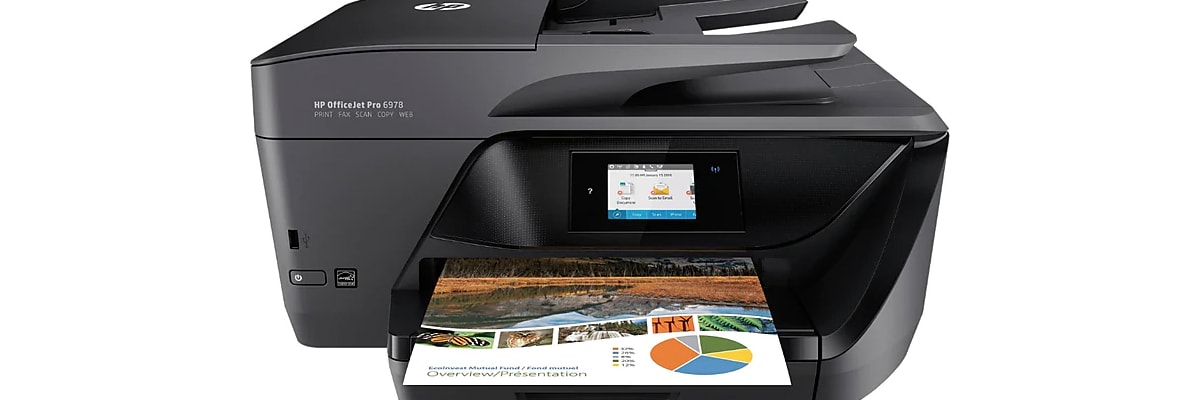
Return navigate_next
The All-in-One Printer Explained: What to Look For
March 8, 2021 *
If you’re in the market for a new printer for the first time in a while, there are plenty of terms to keep in mind. One term you’ll come across quickly in your search is the all-in-one printer. What exactly does this mean, and what should you look for in choosing a top all-in-one printer? Upsie has the answers you’re looking for below.
If you’re considering purchasing a new all-in-one printer, don’t forget to grab an extended accessory warranty to protect it. With so many parts and pieces, the chances of something breaking are relatively high. An Upsie warranty can keep you covered if you face any issues with your new printer.
First up: a definition of terms.

What Is an All-in-One Printer?
So, what exactly is an all-in-one printer? There isn’t exact agreement across the industry on what functions must be included to earn the term, which leads to plenty of confusion.
That said, most printers marketed as all-in-one printers can at least do the following things:
- Print documents
- Scan (via flatbed or document feeder)
- Copy (via the same)
- Fax (if connected to a landline, or via electronic means)
You might find some printers marketed as all-in-ones that cannot fax, as this technology continues to fall further out of favor. But generally, all printers with this label can print, scan and copy.
The all-in-one label does not refer to printer type, so you can find inkjet all-in-ones and laser all-in-ones. It also doesn’t specify whether a printer has other advanced features you might want. These may include wireless printing, hands-free double-sided printing (duplex printing), a document feeder, oversized paper tray, and color capability (on laser models).
Before you start shopping, determine which of these features you need, and make sure any model you’re evaluating has the proper feature set.
What to Look for in an All-in-One Printer
Since there’s such a wide range of printers in this category, what should you look for? Consider the following options. At the same time, recognize that your printing needs are unique to you, so feel free to prioritize these elements in whatever way makes sense for your needs.

Print Speed
Do you need to print many pages rapidly? Laser printers are much faster than inkjets, but there can be a range of speeds for both types. Consider whether a slower speed will hamper what you need to get done.
Print Capacity
How many pages do you need to print per month? If your printing needs are only occasional, how long will the printer sit without being used? Laser printers tend to have higher print capacity, and it also doesn’t suffer if it sits unused. Inkjet printers will struggle if overused and if underused (because the ink can dry up).
Color Print Quality
Do you plan to print vivid, lifelike photos? Do quality and color accuracy matter? If so, inkjet is the way to go. Color laser printers are OK for simple graphics and presentations, but some models struggle with photos.
Long-Term Costs
The printer’s retail cost is only one factor in the budget. It’s better to think in terms of cost per page, because ink and toner refill prices can vary wildly from model to model. Laser toner cartridges are more expensive per cartridge but rarely need to be replaced. Inkjet costs tend to add up higher in the long term.

Brand Reputation
Printers have kind of gotten a bad rap due to some frustrating, unreliable models and brands. Some brands, however, rise above the rest. RTings considers Brother to be the most reliable overall and gives strong marks to HP OfficeJet printers as well. PC World ranks Brother, Canon, Samsung (now a part of HP) and Epson highly, while Ricoh and Lexmark score the worst.
Feature Set
Last, don’t forget that any two all-in-one printers can have very different feature sets. Once you’ve settled on a few models based on the above considerations, refer back to the list near the top of this article. Before you purchase, double-check that whichever models you’re considering can actually do all the things you’ll need out of your printer.
An Extended Warranty for Your All-in-One Printer Makes Sense
Your final choice for an all-in-one printer could be inkjet or laser, budget-minded or packed with premium features. Wherever you land, an extended warranty for your all-in-one printer makes sense. Upsie offers some of the best coverage available, with affordable rates based on your purchase price. There are no deductibles, either.
Choose two or three years of coverage and stay protected from defects, power trouble, internal computer failure, Wi-Fi failure, screen failure and more.
Learn More About Computer Tech:
* This article is over 6 months old and may or may not be updated.
